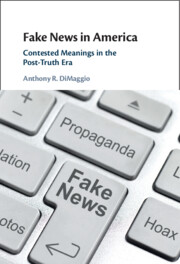Book contents
- Fake News in America
- Fake News in America
- Copyright page
- Dedication
- Contents
- Figures
- Tables
- Contributors
- Acknowledgments
- Introduction
- 1 The Age of Post-Truth Politics
- 2 The Phenomenon of Fake News, Part 1
- 3 The Phenomenon of Fake News, Part 2
- 4 The Phenomenon of Fake News, Part 3
- 5 Fake News as Propaganda
- 6 Fake News and US Foreign Policy in the Trump Era
- 7 The Intensifying Fake News Crisis in the Age of Social Media
- Conclusion
- Bibliography
- Index
2 - The Phenomenon of Fake News, Part 1
Donald Trump’s Twitter Politics
Published online by Cambridge University Press: 30 August 2023
- Fake News in America
- Fake News in America
- Copyright page
- Dedication
- Contents
- Figures
- Tables
- Contributors
- Acknowledgments
- Introduction
- 1 The Age of Post-Truth Politics
- 2 The Phenomenon of Fake News, Part 1
- 3 The Phenomenon of Fake News, Part 2
- 4 The Phenomenon of Fake News, Part 3
- 5 Fake News as Propaganda
- 6 Fake News and US Foreign Policy in the Trump Era
- 7 The Intensifying Fake News Crisis in the Age of Social Media
- Conclusion
- Bibliography
- Index
Summary
In Chapter 2, I review the role of Donald Trump and the right-wing media punditry in cultivating public distrust for journalists, scholars, and other experts. That anti-intellectualism widely resonated with Trump’s base. I review Trump’s use of Twitter as a venue for constructing various meanings of fake news. Trump utilized Twitter to promote right-wing values, communicate with and cultivate support from his base, attack the media, and promote falsehoods. I explore how he worked to stigmatize, manage, and suppress the “fake news” media, while examining years of his Twitter content as president, to understand how he socially constructed meanings of the “fake news” media for his supporters. I identify main themes in his tweets targeting journalists, including lamentations about Russiagate, name-calling, charges of treason, claims about incivility, complaining about poor-quality reporting, charges of liberal bias, and allegations that journalists were not reporting on the allegedly miraculous Trump economy and polls that supposedly demonstrated Trump’s popularity with Americans. A review of national polling data documents how Trump’s Twitter attacks on the media resonated with his supporters, who hold negative views of journalists, support government censorship of the media, and balkanize themselves in a right-wing media echo chamber.
Keywords
- Type
- Chapter
- Information
- Fake News in AmericaContested Meanings in the Post-Truth Era, pp. 31 - 58Publisher: Cambridge University PressPrint publication year: 2023

